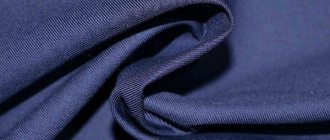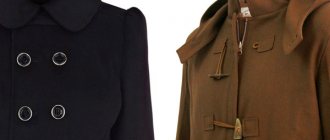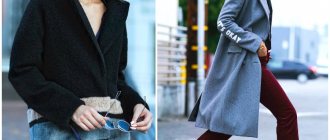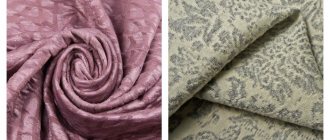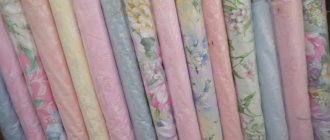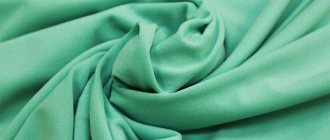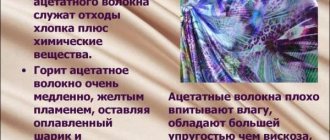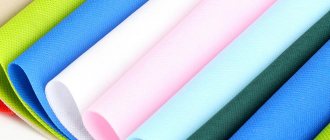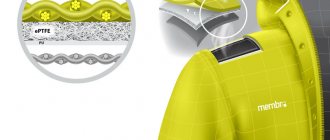What kind of drape fabric is this?
The history of drape begins in France at the end of the 18th century. At that time, weaving looms had just appeared on which it was possible to make dense, thick fabric. Initially, drape was a durable material made of coarse wool, which protected well from bad weather.
Translated from French, the word drap means “cloth”.
Modern drape is wool fabric containing synthetic additives. It is plastic and easy to use, allowing you to give the product different shapes. The material is multilayer, created by double joining of threads and subsequent pressing. Sheep or alpaca wool is used for production.
The pure wool material is heavy and retains its shape well. It does not wrinkle during wear and is abrasion resistant. Pure wool drape does not stretch. If synthetic fiber is added to drape fabric, it becomes elastic. Nylon, viscose or nylon are used as synthetic additives.
Properties of drape that make it very popular:
- does not allow heat to pass through;
- allows air to pass through to the body;
- does not wear out for a long time;
- does not absorb foreign odors;
- does not require complex care.
Drape clothing is universal and adds elegance to the wearer's image. The peculiarity of drape fabric is that the back and front sides have the same appearance. This allows you to re-face things. The disadvantages of drape fabric include its electrification. The smallest hairs will settle on the coat. This type of clothing is not suitable for pet owners.
Another wool material is cashmere. It also comes in pure wool and with the addition of synthetics.
Cashmere and drape differ in properties. Cashmere is thin, elastic, and stretches well. Only pure wool cashmere is suitable for making outerwear. Semi-synthetic does not retain heat well.
View this post on Instagram
Posted by ModaTex (@moda.tex) Dec 19, 2021 at 5:02 PST
Types of drape
Drape is a material that now exists in several varieties. There are differences in fabric composition, density, hairiness and color. Single-layer drape is used to make suits. Demi-season coats are made from one-and-a-half-layer coats, and winter coats are made from two-layer coats.
Italian drape is of high quality. Good fabric is produced by factories in Russia, England, Germany, and Turkey. Russian manufacturers of high-quality drape clothing - Elite, Victoria, Mama Belle.
Pure wool
The most expensive and high-quality variety. It is made from 100% selected wool using the double weaving method. It has high wear resistance and retains its shape for a long time. It is also allowed to include no more than 15% of chemically recovered wool fibers.
Synthetic
Consists of polyester, artificial wool threads. In appearance it is similar to natural drape, but does not have its properties. Cheap fabric, used mainly for making toys and crafts. Upholstered furniture is upholstered with canvas.
Melange
The variety differs in the way it is painted. If the classic drape has a single color, then the melange threads are dyed in two or more colors. Beautiful patterns are created using colored threads. In appearance, this drape resembles tweed.
Unlinted
The surface of this material is smooth. It is obtained by the method of satin or sateen weave of threads. Non-pile fabric has high wear resistance. It is convenient to cut, since you do not need to adhere to the direction of the fibers. Used primarily for sewing men's clothing.
Ratin
The pile is arranged in diagonal stripes. This fabric is made using the twill weave method. Then the material is processed by a press, its surface acquires a herringbone structure. Ratin is an expensive fabric, produced mainly in gray or black colors.
bottle
Patterns are formed from the pile by special arrangement of the fibers. This is a heavy material consisting of merino wool and Tsigai sheep. It has increased rigidity and is used for making outerwear.
Scope of application of drape fabric
The main use of drape is the manufacture of outerwear. A drape coat is an indispensable part of both women's and men's wardrobes. Regardless of the style, a drape coat gives its owner solidity.
A drape coat can be classic, youth, or sporty. It is worn every day to work or just for special occasions. It depends on the style and design of the clothing.
Drape can be combined with any materials. It is combined with corduroy, leather, natural or faux fur. Original combinations are obtained with knitwear, silk, chiffon.
The thin material forms beautiful folds. This allows you to create elegant things with drapery and voluminous details. The coat is combined with wide belts and does not puff up.
Watch an example of cutting and sewing a coat in the video:
Watch the video on how to decate fabric before cutting to prevent it from shrinking in the future:
In addition to making clothes, drape is used in the production of toys and interior elements. In the furniture industry, it is used to make upholstery for chairs, armchairs, and sofas.
Watch the video on how to make a beautiful rose from drape:
Selections of men's coats:
What to wear with a women's drape coat?
In order to create a beautiful and elegant look, you need to know what to wear with a drape coat, and what wardrobe items, shoes and accessories it goes best with. In reality, this product looks good with most things, however, there are exceptions that stylists recommend avoiding. Thus, it is not recommended to combine outerwear made of drape with miniature bags and excessively open shoes and sandals.
What to wear with a women's drape coat?
Short drape coat
A women's drape short coat goes perfectly with plain straight or slightly tapered trousers and high-heeled, wedge or platform shoes or ankle boots. This outerwear can be combined with skirts and dresses of various styles, however, options with a not too wide hem, approximately knee-length, look best with it.
In addition, an incredibly stylish combination would be a tight miniskirt, high boots and insulated tights or leggings. The only thing you should avoid when creating a fashionable look with a drape short coat are trousers and flared jeans, which in tandem with this product will look ridiculous.
Long drape coats
An elegant women's long drape coat looks best with classic trousers, as well as dresses and maxi skirts. Tall girls can afford almost all shoe options - from insulated moccasins to stylish thick-heeled boots and elegant stiletto boots. If the young lady is petite, she should take into account that a long drape coat can visually “steal” several centimeters of height, so in such a situation it must be combined with elegant shoes with high heels, wedges or platforms.
Drape care
Caring for drape clothing is easy. Once a season, clean the product with a brush and soap foam. As it gets dirty during wear, remove dust and hairs with a damp brush.
It is not recommended to wash clothes yourself in a washing machine; if they are heavily soiled, you should take the item to the dry cleaner. During the off-season, the coat is stored in a special case.
Suits and skirts made of thin single-layer drape can be machine washed. A delicate wash cycle is used; powder or gel should be used for woolen items. After washing, the product should be laid out on a flat surface until completely dry.
Sun drying is prohibited. Wrinkles may appear on items if they are not dried properly. It is difficult to get rid of them; use a steamer or iron the product through damp gauze.
See how to care for your coat:
How to care
Practical material does not require much time to maintain.
The main thing for such products is dry cleaning. Outer winter and demi-season clothing should be cleaned with a brush at least once a season. Mostly before putting it away for storage. It is not recommended to wash large items, but it is better to take them to the dry cleaner.
To remove stains and local dirt, for example on sleeves, use a soft brush and soap solution. Remove any residue with a damp sponge and hang the clothes on hangers to dry.
The manufacturer allows some types of suits, trousers and skirts made of drape to be washed at +30° by hand or in a machine in the delicate mode, as indicated on the label. Powder or wool gel is used as a detergent. Rubbing and twisting such things is prohibited. After rinsing in a large volume of water, the products are left to drain. Dry drape clothes in a straightened state on a horizontal surface. A shady place on the street or balcony is suitable for this.
Due to improper drying after getting wet in the rain and storage, creases appear on the surface of the fabric. Removing them can be difficult. The folds are smoothed out through moistened gauze in several folds. It is much more effective to use a steamer or iron with this function.
In the previous article (“How to choose a coat for your body type”) we wrote about how to choose a coat to suit your figure. Now you know which model is right for you. Today we will talk about the properties of coats made from different fabrics, as well as how to choose and try on a coat correctly (Yes, yes! And there are rules for trying on).
Main coat fabrics
- coat “
ahead of the rest” in terms of heat retention. In addition, this material is very soft and pleasant to the touch, it hardly wrinkles, not to mention the fact that it is natural. But from long wear, pellets form on the surface of the product. Perhaps this is the only negative. To “overcome” this disadvantage, synthetic threads are woven into the main composition of the fabric. Which, by the way, immediately affects the price of the product. - Wool
coats retain heat well. The fabric is soft to the touch. To impart certain properties to the material (wear resistance, strength, etc.), synthetics or viscose are added. - Drape
is perhaps the first fabric that is associated with a coat among those who were born and raised in the USSR. The drape is very dense, which is why it holds its shape well and retains heat. But how heavy it is. - A coat made of tweed
(fabric with a small pile, usually of a diagonal weave - reminiscent of a herringbone) is very durable due to the combined weave of threads. For those who love practicality - A leather
coat that is properly tailored to your figure looks very impressive. The leather is very practical in terms of care, which is especially important for the Ural slushy off-seasons - wipe it with a damp cloth - and the coat is clean again. True, a leather coat without an insulated lining is only suitable for warm weather. - Coats made of cotton fabrics
(such as velor, jacquard, corduroy, etc.) are distinguished by good wear resistance and practicality.
How to choose a coat
Now that we have looked at the different types of coat fabrics, we can move on to how to choose the right coat. Before you start trying on your coat, check the following:
- The coat material must be smooth and uniform
- The quality of the seams - they must be neat and even
- The sleeves are the same length (laugh, laugh, but anything can happen)
- Look at how the bottom edge of the coat is folded - the hem should be at least 3 cm.
- If the coat uses faux fur as insulation, it must be stitched. If there are no seams, then the flaps of fur were glued together when sewing the product. And when worn, such a lining can “spread”
